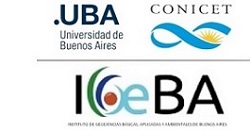Quaternary tectonics along oblique deformation zones in the Central Andean retro-wedge between 31°30′S and 35°S
Libro: Geodynamic processes in the Andes of Central Chile and Argentina

Capítulo: Quaternary tectonics along oblique deformation zones in the Central
Andean retro-wedge between 31°30′S and 35°S
Autores: J. M. Cortés, C. M. Terrizzano, M. M. Pasini, M. G. Yamin and A. L. Casa
Abstract
The distribution of the Quaternary deformation in the outer retro-wedge of the
Andes (31°30′–35°S) is controlled by the subduction geometry, the position of the
structural front, and the location of oblique pre-Cenozoic mechanical anisotropies. In
the Southern Precordillera, Quaternary structures tend to group along the Barreal–Las
Peñas deformation zone with a NW to NNW trend. This Cenozoic belt (31°30′–32°40′S)
developed on the northern segment of the Triassic Cuyo Basin and broadened laterally
during the Quaternary. New radiocarbon ages on dam deposits confirm Holocene
tectonic activity on the northwestern edge. The oldest ages of dam deposits are
5810±90 a BP (Cabeceras Creek) and 810±50 a BP (Dolores Creek).

Palaeoseismological and seismic data suggest active tectonic growth on the NW and
SE extremes. Quaternary tectonics has contributed to modifying the relief along this
oblique belt. This contribution is evident from the tectonic uplift of blocks
(minimum 90–120 m in the Barreal block), the initial development of intermontane
basins (Pampa de los Burros Basin), the Quaternary rejuvenation of tectonic
depressions (at least 32–37 m of tectonic subsidence in the Vizcacheras half-graben)
and the incipient development of low-relief morphotectonic units by soft-linkage of
Quaternary structures.
